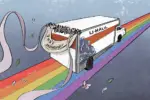A simple Google search of “Hallmark movies” yields a predictably homogeneous result: a row of movie posters featuring white, heterosexual couples surrounded by evergreen foliage and dazzling string lights. Hallmark Christmas movies are not just silly and festive, but they also represent a culture that is unwilling to change in the face of increasing pushes for diversity. In recent years, the Hallmark Channel has come under fire for their lack of diversity.
This year alone, Hallmark is releasing a record number of 24 Hallmark Christmas movies. Out of those 24 titles, only four of them feature black lead characters. While some people complain that this number is down from last year’s standing of five out of 21, this argument misses the point that this issue shouldn’t come down to mere percentage points — in this case, it’s the difference between 24% and 16%.
This statistic also fails to recognize the network’s adherence to Christianity and heterosexuality. The fact is that Hallmark’s representation record is shoddy, especially in comparison to holiday movie competitors like Netflix and Freeform.
It’s a Christmas Miracle…there are minorities on the hallmark channel #hallmarkchristmasmovies
— MakeseMotley (@MakeseMotley) November 30, 2019
Freeform, previously branded as ABC Family, has been airing their popular seasonal programming block “25 Days of Christmas” for years. While Freeform does not produce nearly as many Christmas movies as Hallmark, the network has made steps to further diversify the stories that they do feature.
This year, the channel is releasing two holiday films, “Ghosting: The Spirit of Christmas” and “Same Time, Next Christmas,” both of which have leads of color in addition to other cast members who are people of color. In this way, Freeform has increasingly portrayed stories that are more representative of their viewership.
Similarly, Netflix has also upped their holiday movie game. This holiday season, they have dropped five new titles for us all to binge including “Let It Snow” and “Holiday in the Wild.”
Again, this strain of teen romance, animation and elephant sanctuaries does well to expand the scope of the holidays. There are no mentions of a hardwired city woman returning to her small town roots for the holidays and miraculously finding the love of her life in a cowboy. No. Netflix’s lineup attempts to break some molds and succeeds at showing more than another happy couple. This attempt is much more than we have seen from Hallmark.
While the first Hallmark Christmas movie was released in 2002, the full-on “Countdown to Christmas” block was not established until 2010. Since then, the Hallmark network has released hundreds of holiday films. One of the most frequent faces featured in these movies is “Full House” actress Candace Cameron Bure.
Bure stars in several of Hallmark’s most popular Christmas movies including “Christmas Under Wraps,” which premiered in 2014 with a record 5.75 million viewers. Many of these films feature the familiar yet safe storylines over and over again, each with their own slight twists.
The spirit of Christmas brought Lauren @CandaceCBure to Grandon Falls, and now it’s bringing you right back to @TheBubblySesh for a #ChristmasTown recap! Listen in now here: https://t.co/uFrR66tNDt #CountdownToChristmas pic.twitter.com/RtOsqTrVtj
— Hallmark Channel (@hallmarkchannel) December 2, 2019
All of this considered, it still brings up the question, why are Hallmark Christmas movies still so popular? Do the whitewashed sensibilities of these films speak to a larger misguided notion of nostalgia? Or is it because the Hallmark Channel successfully brands itself as a family-friendly network?
Despite the formulaic nature of their original movies, they are notably profanity free and lack the presence of sex or significant drama. These factors may contribute to Hallmark’s popularity, particularly around the holiday season when families are more likely to be gathering together around the TV.
However, the Hallmark Channel’s aim of being as noncontroversial as possible through their Hallmark Christmas movie category is not an excuse for lacking diversity. In an interview with The Hollywood Reporter, Crown Media Family Networks’ CEO Bill Abbott said, “In terms of broadening out the demographic, it’s something we’re always thinking about, always considering and we’ll continue to make the movies where the best scripts are delivered to us and what we think have the most potential.”
Abbott goes on to say that the process of reviewing scripts is a complex process, and with the network releasing several dozen original titles a year, there is not ample time to spend emphasizing diverse casting and stories to creative teams.
This excuse seems a bit flimsy, however, considering that in 2014, Hallmark parent company Crown Media created its own in-house production company. This means that Crown Media effectively has full creative control over what movies are produced for the Hallmark Channel. Also, just because a story does not explicitly require black actors or actresses does not mean that they still cannot be featured as leads. The Hallmark Christmas movie library is chock-full of extremely generic storylines that are not race-specific.
For example, one of my personal favorites out of the lineup of Hallmark Christmas movies is “Christmas Festival of Ice” from 2017. “Christmas Festival of Ice” is not my favorite Hallmark movie because it’s deep or well-developed — because it’s not — but instead because (SPOILER ALERT) the lead character decides to give up her law degree in order to pursue a career alongside her new boyfriend as an ice sculptor.
I think about this movie a lot. I could go on and on about why the entire premise makes no sense or how the economics of a small town cannot support the livelihoods of not one, but two full-time ice sculptors.
https://twitter.com/HayleyCardu/status/1201834098593075201
Regardless, “Christmas Festival of Ice” is a prime example of just how narrow Hallmark Christmas movies’ scope of Christmas is: whitewashed, generic and the epitome of first world problems.
In the same interview with The Hollywood Reporter, Abbott discussed the potential for different faiths to be portrayed in their Countdown to Christmas: “[It’s] a little bit more difficult because we don’t look at Christmas from a religious point of view, it’s more a seasonal celebration. Once you start to slice it more finely within individual religions it’s a little bit tougher to necessarily tell that story in a way that doesn’t involve religion and we always want to stay clear of religion or controversy.”
Again, this explanation comes off as lackluster because nowadays there are abundant resources on how to respectfully portray different religions in ways that are both authentic and inclusive. These resources could be applied any to any storyline or character in the Hallmark Christmas movie universe.
Ultimately, Hallmark seems to be content in their position of inoffensive whiteness and heteronormativity. Although Christmas or holiday movies may seem like a trivial point to get hung up on, it’s important to remember that media is meant to provide a lens through which we see ourselves. So this holiday season, try and spend a little time to introspect on the implications of watching the premiere of the latest Hallmark Christmas movie.
















